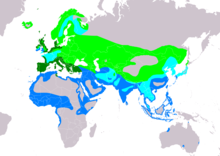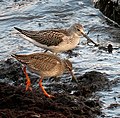Common redshank
| Common redshank | |
|---|---|

| |
| Breeding plumage | |

| |
| Non-breeding (winter) plumage | |
| Scientific classification | |
| Domain: | Eukaryota |
| Kingdom: | Animalia |
| Phylum: | Chordata |
| Class: | Aves |
| Order: | Charadriiformes |
| Family: | Scolopacidae |
| Genus: | Tringa |
| Species: | T. totanus
|
| Binomial name | |
| Tringa totanus | |

| |
| Range of the common redshank Breeding Resident Passage Non-breeding
| |
| Synonyms | |
| |
The common redshank or simply redshank (Tringa totanus) is a
Taxonomy
The common redshank was formally described by the Swedish naturalist Carl Linnaeus in 1758 in the tenth edition of his Systema Naturae under the binomial name Scolopax totanus.[2] It is now placed with twelve other species in the genus Tringa that Linnaeus had introduced in 1758.[3][4] The genus name Tringa is the Neo-Latin name given to the green sandpiper by the Italian naturalist Ulisse Aldrovandi in 1603 based on Ancient Greek trungas, a thrush-sized, white-rumped, tail-bobbing wading bird mentioned by Aristotle. The specific totanus is from Tótano, the Italian name for this bird.[5]
Six subspecies are recognised:[4]
- T. t. robusta (Schiøler, 1919)[6] – breeds in Iceland and the Faroe Islands; non-breeding around the British Isles and west Europe
- T. t. totanus (Linnaeus, 1758) – breeds in west, north Europe to west Siberia; winters in Africa, India and Indonesia
- T. t. ussuriensis Buturlin, 1934[7] – breeds in southern Siberia, Mongolia and east Asia; non-breeding in Africa, India and southeast Asia
- T. t. terrignotae Meinertzhagen, R. & Meinertzhagen, A., 1926 – breeds in southern Manchuria and eastern China; non-breeding in east and southeast Asia
- T. t. craggi Hale, 1971 – breeds in northwest China; non-breeding in east and southeast Asia
- T. t. eurhina (Oberholser, 1900)[8] – breeds in Tajikistan, north India and Tibet;[9] non-breeding in India and the Malay Peninsula
Description
Common redshanks in breeding plumage are a marbled brown color, slightly lighter below. In winter plumage they become somewhat lighter-toned and less patterned, being rather plain greyish-brown above and whitish below. They have red legs and a black-tipped red bill, and show white up the back and on the wings in flight.
The
Distribution and habitat
The common redshank is a widespread breeding bird across

Behaviour and ecology
They are wary and noisy birds which will alert everything else with their loud piping call.
Breeding
Redshanks will nest in any wetland, from damp meadows to saltmarsh, often at high densities.[13] They lay 3–5 eggs.
Food and feeding
Like most waders, they feed on small invertebrates.
Status
The common redshank is widely distributed and quite plentiful in some regions, and thus not considered a
Gallery
-
Bird (non-breeding) in flight (Venetian Lagoon, Italy)
-
Common redshank in theHailuoto Island, Finland
-
Common redshank is significantly smaller than, for example the Common greenshank
-
Redshank searching for food
References
- ^ . Retrieved 19 November 2021.
- ^ Linnaeus, Carl (1758). Systema Naturae per regna tria naturae, secundum classes, ordines, genera, species, cum characteribus, differentiis, synonymis, locis (in Latin). Vol. 1 (10th ed.). Holmiae (Stockholm): Laurentii Salvii. p. 145.
- ^ Linnaeus, Carl (1758). Systema Naturae per regna tria naturae, secundum classes, ordines, genera, species, cum characteribus, differentiis, synonymis, locis (in Latin). Vol. 1 (10th ed.). Holmiae (Stockholm): Laurentii Salvii. p. 148.
- ^ Rasmussen, Pamela, eds. (July 2021). "Sandpipers, snipes, coursers". IOC World Bird List Version 11.2. International Ornithologists' Union. Retrieved 20 November 2021.
- ISBN 978-1-4081-2501-4.
- ^ Schiøler, E.L. (1919). "Om den Islandske Redben (Totunus calidris robustus)". Dansk Ornitologisk Forenings Tidsskrift (in Danish). XIII: 207–211.
- ^ Buturlin, S.A. (1934). Полный определитель птиц СССР [Polnyi Opredelitel Ptitsy SSSR] [Complete keys to the birds of the USSR] (in Russian). I: 88.
- ^ Oberholser, H.C. (1900). "Birds from Central Asia". Proceedings of the U.S. National Museum. XXII: 207–208.
- .
- S2CID 86221767.
- ^ Wiles, Gary J.; Johnson, Nathan C.; de Cruz, Justine B.; Dutson, Guy; Camacho, Vicente A.; Kepler, Angela Kay; Vice, Daniel S.; Garrett, Kimball L.; Kessler, Curt C.; Pratt, H. Douglas (2004). "New and Noteworthy Bird Records for Micronesia, 1986–2003". Micronesica. 37 (1): 69–96. Archived from the original on 5 May 2009.
- ^ Two Tagged migratory birds spotted in salt pans in Manakudy bird reserve, The Hindu, Thiruchirappalli, Tamil Nadu Edition, India, pp4, 12.04.2021. thehindu.com
- ^ Cadbury, C. J.; Green, R.; Allport, G. (1987). "Redshanks and other breeding waders of British saltmarshes". RSPB Conservation Review. Vol. 1. pp. 37–40 – via ResearchGate.
- ^ "Species". Agreement on the Conservation of African-Eurasian Migratory Waterbirds (AEWA). Retrieved 14 November 2021.
External links
- Chisholm, Hugh, ed. (1911). . Encyclopædia Britannica (11th ed.). Cambridge University Press.
- Redshank Images and documentation
- Ageing and sexing (PDF; 1.4 MB) by Javier Blasco-Zumeta & Gerd-Michael Heinze
- "Tringa totanus". Avibase.
- "Common redshank media". Internet Bird Collection.
- Common redshank photo gallery at VIREO (Drexel University)
- Interactive range map of Tringa totanus at IUCN Red List maps
- Audio recordings of Common redshank on Xeno-canto.
- Tringa totanus in Field Guide: Birds of the World on Flickr
- Common redshank media from ARKive





